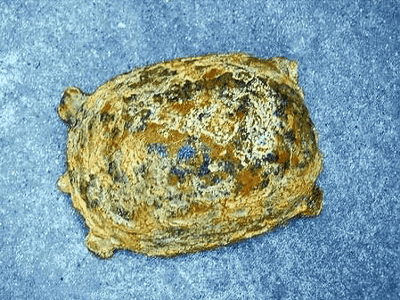A new fossil of the Anomalocaris family that lived 500 million years ago is discovered

Paleontologists at the Royal Ontario Museum in Canada have discovered fossils of a new species of creature that appears to have inhabited the Cambrian period.
A giant nektobenthic radiodont from the Burgess Shale and the significance of hurdiid carapace diversity | Royal Society Open Science
Massive new animal species discovered in half-billion-year-old Burgess Shale | Royal Ontario Museum
https://www.rom.on.ca/en/about-us/newsroom/press-releases/massive-new-animal-species-discovered-in-half-billion-year-old
In the Cambrian period, which is divided from about 543 million years ago to about 488.3 million years ago, the Cambrian explosion that covered almost all of the earth and gave birth to a wide variety of organisms in the sea occurred. It has been. The Titanokorys gainesi discovered this time is also considered to have originated in the Cambrian period, and is taxonomically considered to belong to the same taxon as the Cambrian champion Anomalocaris.

by UNE Photos
According to Jean Bernard Caron and others who discovered Titanokorys gainesi, the creature , like many anomalocaris, had a streamlined body, circular teeth like pineapple cuts, and multiple torso lines. In addition to having fins, a large shell covered half of the body. You can see the whole picture in the tweet below.
The long awaited 'mothership' is here. Just out from the @ROMtoronto #BurgessShale team, please welcome #Titanokorys gainesi, a new species of giant #Cambrian #radiodont . #VanierCanada @eebtoronto @UofT @UofT_Palaeo https://t.co / fiq0dckQ28 (open access link should go live soon) pic.twitter.com/sYLlj8Qc4O
— Joe Moysiuk (@CambroJoe) September 8, 2021
Caron pointed out that 'the biggest feature is its length.' The length of Titanokorys gainesi is estimated to be about 50 cm, which seems small by modern standards, but it was surprisingly large in the Cambrian period, when creatures about the size of the little finger were common.
Although it is unclear why Caron has such a large body and a large shell that is about half the size of the body, 'modern crustacean shells play a role in defense, feeding, and hydrodynamics. I think the shell of Titanokorys gainesi has changed to play a similar role. '
This time, Titanokorys gainesi has been found in the Burgess Shale , a fossil stratum of the Canadian Rockies. Burgess Shale is Anomalocaris and opabinia , Hallucigenia also known that the Cambrian organisms, such as have been found a large number, has further fossil mining is continued in the region.
Related Posts:







